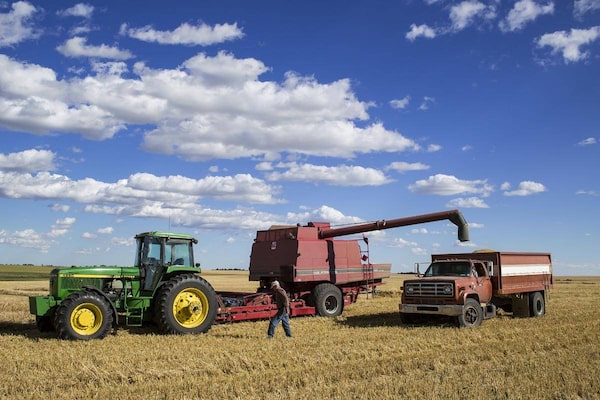
Farmers harvest grain crops near Irricana, Alberta.Chris Bolin/The Globe and Mail
Even if the North American free-trade agreement bites the dust, the prospects for Canadian farming are likely sunnier than you think.
Admittedly, Canada's negotiators are tussling testily with their counterparts from the United States and Mexico, with a key agricultural issue – supply management – in contention.
Nevertheless, the longer-term outlook for growth and productivity improvement in Canadian agriculture appears strong. The equation is simple, says Jean-Charles Le Vallée, associate director of Food Horizons Canada, a research arm of the Conference Board of Canada.
"If we look to the future of food, demand will grow as the population grows," Dr. Le Vallée says.
"If we look toward 2050, for example, we're looking at between 9.5 and 9.7 billion people in the world, and Canada's population will be between 50 and 55 million," he says. "Most of the new demand for food will come from outside Canada, so you really have to consider trade as an opportunity for growth."
The federal government is betting on Canada's agricultural sector. In the federal budget tabled last March, Finance Minister Bill Morneau put forward the agri-food sector as one of six key areas that will gain from a new Innovation and Skills Plan that will pump government resources into boosting growth and creating jobs.
The government has committed $8.2-billion to the plan, which agri-foods will share with what Ottawa considers other "big bet" sectors, among them advanced manufacturing, clean technology and digital industries.
The goal for agri-food is to increase Canada's exports to $75-billion a year by 2025, up from nearly $56-billion in 2016. "There's opportunity there," says Dr. Le Vallée.
It's an achievable goal, says Ron Bonnett, president of the Canadian Federation of Agriculture.
"Growing middle-class populations in foreign markets are hungry for Canadian food, and growing domestic support to improve our agri-food systems will help us meet those demands to become one of the world's leading suppliers," he says.
Among the formidable obstacles, however, are the potential for NAFTA to fall apart amid longstanding international displeasure with Canada's system of price supports that protect farmers.
At the same time, as the United States puts up new barriers – and, in Mexico's case, possibly an actual wall – Canada has ample room to expand its food exports as well as market its agricultural machinery and technology in Europe and Asia.
"We are pleased to see the government recognize the critical role innovation plays in growing our sector," says Jim Everson, who until last spring was executive director of Soy Canada, which represents some 31,000 producers across the country.
Some companies are already moving fast in ag-related tech.
"We see a big opportunity for water-retention technology," says Gary Shokar, president of AvenEx Coating Technologies Inc., based in Vancouver. The company has a growing export business in India and other parts of South Asia, where it sells a high-tech fabric lining that can be placed over fields to help them retain moisture.
"We don't have a lot of competitors, and the companies that are in this space tend to rely on their existing technologies," says Mr. Shokar, whose company has a 10-person research and development team.
Dr. Le Vallée and the Conference Board say that Canadians generally should be pleased by the performance of the agricultural sector, even if there is room to do better.
In 2015, the board's Food Horizons Canada released a report card on the sector comparing Canada's performance with that of 16 other members of the Organization for Economic Cooperation and Development (OECD). Canada received a grade of B-minus.
Canada's farms are generally well-capitalized and productive, the report found. But Canada also "punches below its weight in food innovation, product market regulation, livestock production and representation among leading global food companies."
Canada also maintains relatively high trade barriers for certain commodities such as wheat and barley, Dr. Le Vallée says. "Lowering these would certainly help, especially in terms of emerging markets," he says, because Canada is a net exporter and, presumably, trading partners would lower their barriers in return.
Canadian agriculture also has an opportunity to grow if the sector works on solutions for climate change, says Heather Fraser, an adjunct professor at the University of Toronto's Rotman School of Management. "Many areas are going to be under water, and we have a lot of land," she says.
Another key to increasing exports, Ms. Fraser says, will be to anticipate the types of food and nutrition that new and emerging export markets will seek from Canada.